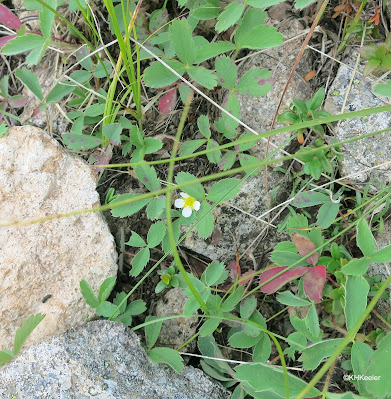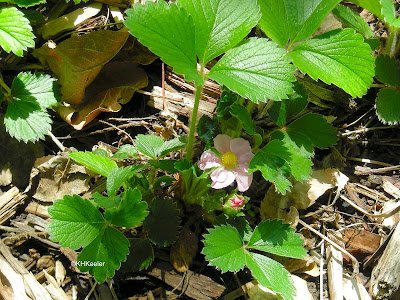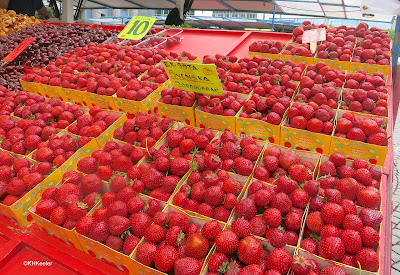Strawberries, genus Fragaria in the rose family, Rosaceae, are a popular fruit and have been for millennia. Twenty to 24 species are recognized, with cultivated strawberries adding many hybrids and varieties. They are native around the world, mainly in the northern part of the Northern Hemisphere, plus a few Southern Hemisphere species.
 |
| strawberries, Fragaria |
The Flora of North America says the name Fragaria comes from fraga, Latin for fragrance, and -aria, possession, so, a sweet-smelling fruit. Other explanations exist; for example Wikipedia says fragum is strawberry in Latin and -aria makes it a feminine plant name. My Latin dictionary agrees that fragum is the word the Romans used for strawberry but says fragrans is Latin for fragrant. In Latin declensions, fraga is the plural of fragum, in which case fraga means strawberries rather than fragrant. However, some of forms of the noun add an r, for example fragris and fragra, so would have sounded a lot like "fragrant" to Romans, which could explain the otherwise mysterious choice of fraga for strawberry. (Linguists always want to see why people chose this name and not some other one.) Linnaeus created the scientific name in the 1750s, adding -aria, likely making it "of strawberries" to refer to the whole genus not a particular strawberry.
 |
| wild strawberry |
 |
| Strawberries, Fragaria x ananassa |
Across much of the world, you can find native strawberries. Different species in different places. All are herbs that spread by runners (stolons). Strawberry flowers range from white through quite pink. In most species the leaves have three lobes, but a few species have five lobes. The fruits are usually red when ripe but sometimes quite pale. Some fruits taste very sweet but others are quite tart. In all cases, they are believed to be distributed by animals: animals eat the fruit, taking in the seeds, and disperse the seeds in their feces. Fruits turn red and become soft and tasty, from green, hard, and flavorless, when the seeds are fully ripe. (Trees that are called strawberry trees--there are several--have fruits that remind people of strawberries but they are not closely related to strawberries.)
 |
| unidentified strawberry |
The genus Fragaria, all of them called strawberry, is famously polyploid. The wood or woodland strawberry, Fragaria vesca, native all over North America, is diploid (2n = 14), as are a number of other species. But, chromosome counts of other species found tetraploid (4x) species, such as Fragaria orientalis. Other species proved to be hexaploids (6x) as Fragaria moschata, widely cultivated in Europe. And then there were octoploids (8x) like the common or Virginia strawberry Fragaria virginiana, native all over North America, and decaploids (10x) as the Cascade strawberery, Fragaria cascadensis, first described in 2012, and found only on the western slopes of the Cascade Mountains in Oregon. In general, leaves, flowers and fruit are bigger in the higher polyploids of strawberries. Our cultivated strawberry is not found in the wild. Two strawberry species crossed in cultivation in Europe some 200 years ago to create it. Those two strawberries, Fragaria virginiana and Fragaria chiloensis are both octoploid (8x) species, We recognize the hybrid as Fragaria x ananassa, a named hybrid (the x means hybrid) and it has really big fruits. See photo above with penny for scale. Fragaria as a whole is a classical example of a genus where many species formed by hybridization followed by polyploidy (whole genome duplication). (See previous blog link).
 |
| woodland strawberry, Fragaria vesca |
Liston, A., R. Cronin, and T.-L. Ashman. 2014. Fragaria: A genus with deep historical roots and ripe for evolutionary and ecological insightss. American Journal of Botany 101: 1686-1699. link
Oxford English Dictionary, s.v. “straw (n.1),” March 2024, https://doi.org/10.1093/OED/7646869728.
Oxford English Dictionary, s.v. “strawberry (n.),” March 2024, https://doi.org/10.1093/OED/1031267711.
Staudt, G. 2020. Fragaria. Flora of North America. link

No comments:
Post a Comment